OPEN AIR MUSEUMS/ ART GALLERIES - INDIA
|
Namaste! It is an amazing feeling for us to share our heritage with you. India has always astonished travellers around the world! This edition of TravNama brings you another step closer to the beauty of ancient India that makes the country one of the most charming places to visit around the globe.
Sometimes, walls of museum are not enough to hold the history and glory of past. We will take you to the cities, which are exhibiting their past glory under the open sky. These are not less than any Open air museum or art gallery,

which have lots of stories and tales to tell, facts to share, culture to absorb, art and engineering to admire.
So here are some of the impressions from those bygone eras:
HAMPI
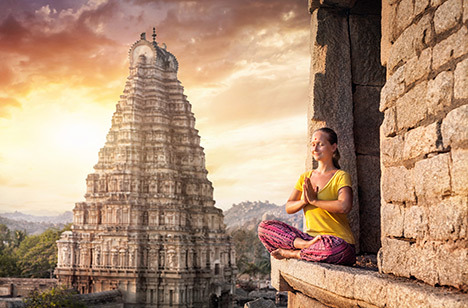 Hampi, a UNESCO world heritage site, which also happens to be a pilgrimage site for the Hindus, has a glorious past. Settled near Tungabhadra River, the Vijayanagara Empire's Capital City, Hampi, was a grand city known for its prosperity and wealth in the 14th century. It was the wealthiest city in India and the second largest medieval era city in the world and, in good times, had attracted traders from as far as Persia and Portugal.
Hampi, a UNESCO world heritage site, which also happens to be a pilgrimage site for the Hindus, has a glorious past. Settled near Tungabhadra River, the Vijayanagara Empire's Capital City, Hampi, was a grand city known for its prosperity and wealth in the 14th century. It was the wealthiest city in India and the second largest medieval era city in the world and, in good times, had attracted traders from as far as Persia and Portugal.
The grandeur was such that it is believed that diamonds were sold here in the streets. Unfortunately, like many other cities with similar glory, Hampi was attacked, conquered, plundered and destructed by Muslim sultanates in 1565.
Spread over 41.5 square kilometers, the Ruins of Hampi have more than 1600 remains, including temples, forts, royal monuments, stepwells, and other sacred structures of the last Hindu kingdom of southern India. The monuments in the complex do not have any inscriptions, making it difficult to establish their functionality in those times. Some of the highlights here are:
• Virupaksha Temple and market complex: This oldest shrine is an active Hindu temple and is the most visited site by pilgrims and tourists. The complex has many other small temples, a community kitchen, a water tank, and ruins of a 01 Km long stone market, with shops on ground and first floor completely built out of granite stones.
• Krishna Temple and market complex: Presently in ruins, the temple dates back to 1515 CE and has a long market street in front of it, also called bazaar.
• Achyutaraya Temple and market complex: One of the four largest complexes in Hampi, it has a 100 column hall and ruins of major market street in front of it.
• Vitthala Temple and market complex: This temple near Tungabhadra River banks stands distinct from other temples in Hampi, artistically. The attention seeker here is the Stone Chariot lying in the courtyard, mostly visible in the pictures representing Hampi.
There are many other small monuments that can be explored here. Admire the carvings, inscriptions, elaborate frescoes, and large courtyards of Hazara Rama temple.
Pattabhirama temple complex and Kondandarama temple possesses some interesting monuments which can be explored along with some riverside monuments. The largest monument in the complex, Mahanavmi Dibba, is also one of the highest points in the royal center. Pass by many step wells and community kitchens with feeding halls in the temples while exploring the complex.
Another important monument not to be missed here is Gajashala (Elephant Stable), with eleven square chambers, and Lotus Mahal with two story pavilions.
Surrounded by the boulders and many hills, Hampi also offers multiple trekking options as well as sunrise & sunset views.
In November, an annual Hampi Festival showcases culture and dance, and all the monuments and ruins are lit up, making it a photogenic view. Enjoy Hampi with a short Video
SHEKHAWATI
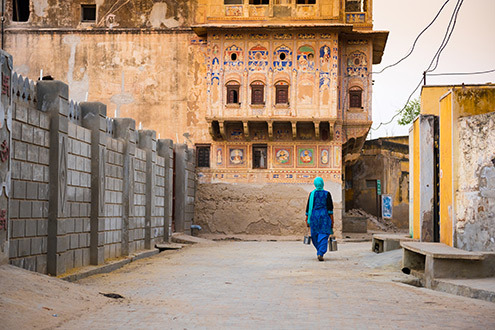 It is the region well known for frescos covered abandoned Havelis (Mansions) beholding the stories of its heydays. Right from the 14th century, Shekhawati had a very strategic location on the trade route between ports of Gujarat and cities around the Ganges plains. The towns in Shekhawati served as the trading posts, and the traders started constructing their Havelis (mansions) here. As the businesses flourished with time, the region saw a large number of Havelis being constructed between the 18th and 20th centuries.
It is the region well known for frescos covered abandoned Havelis (Mansions) beholding the stories of its heydays. Right from the 14th century, Shekhawati had a very strategic location on the trade route between ports of Gujarat and cities around the Ganges plains. The towns in Shekhawati served as the trading posts, and the traders started constructing their Havelis (mansions) here. As the businesses flourished with time, the region saw a large number of Havelis being constructed between the 18th and 20th centuries.
A sort of competition to show the affluence emerged among the traders, which resulted in a new Haveli constructed, bigger than the adjacent and highly decorated with frescos.
A large door guards a typical Haveli in Shekhawati. Once inside, you reach the first courtyard used by the family's male members to meet their business prospects and discuss the deals. Next to it is the second courtyard, which is meant for women only. This courtyard has bedrooms, kitchens, and staircases leading to the roof and balconies. You may find Havelis with more than two courtyards as well, to facilitate all the luxuries within the walls so that the women of the house do not have to venture out. While the architecture in each of these Havelis is worth noticing, it is the fresco paintings using vegetable colors on the walls, which attracts the most attention. On the exterior and interior walls of Havelis, various scenes from the mythology, gods and goddesses, and other living creatures were painted, telling intriguing stories and tales.
 When one enters the town, Havelis, with paintings on different themes, mostly from Hindu epics like 'Ramayana' and 'Mahabharata' lying on both sides of the streets, welcome the passersby.
When one enters the town, Havelis, with paintings on different themes, mostly from Hindu epics like 'Ramayana' and 'Mahabharata' lying on both sides of the streets, welcome the passersby.
Interestingly, one may also notice the influence of various eras in these fresco paintings, from Mughals and Rajputs to that of British, depicting court scenes and lifestyles. Some of the Havelis are painted with modern inventions of that time like trains, telephones, cars, etc.
The region suffered a lot, as the traders moved to bigger cities for better luxuries and business, leaving the Havelis at the mercy of caretakers.
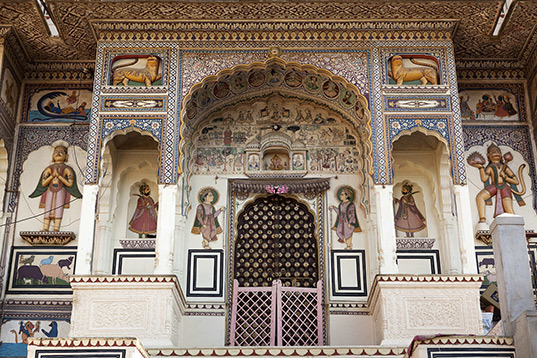 Many villages in the Shekhawati region possess these abandoned Havelis, forts, and temples, but Mandawa and Nawalgarh have some well-preserved Havelis, with some converted into hotels as well.
Many villages in the Shekhawati region possess these abandoned Havelis, forts, and temples, but Mandawa and Nawalgarh have some well-preserved Havelis, with some converted into hotels as well.
The best way to absorb the beauty of these magnificent mansions is to explore by foot so as not to miss any of the beautiful frescos. Enjoy Fatehpur, a small hamlet in Shekhawati with a short video
|
MAHABALIPURAM
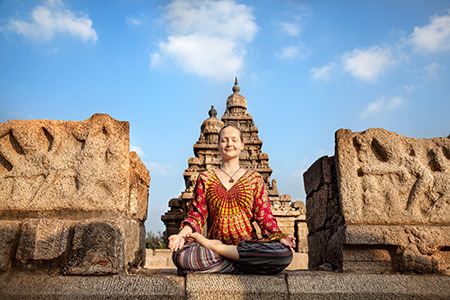 Also known as Mamallapuram, it got its name from the legend, wherein demon king Mahabali was killed by Lord Vishnu (Hindu God). Ruled by Pallavas between the 03rd and 09th century CE, it was among the two major port cities of their kingdom.
Also known as Mamallapuram, it got its name from the legend, wherein demon king Mahabali was killed by Lord Vishnu (Hindu God). Ruled by Pallavas between the 03rd and 09th century CE, it was among the two major port cities of their kingdom.
The Pallavas were pioneers in art and architecture, and as they prospered economically in this region, they made best use of their resources here. The town exhibits Pallavas' innovation in rock-cut caves, temples made from a single rock, and bas-reliefs, reflecting their creativity and art.
This beautiful town lying on the Coromandel Coast has around forty monuments expressing religion, culture, and mythology scenes over the rocks. While some are standing as a complete masterpiece, some are left incomplete. Also listed as a UNESCO world heritage site, you can see the Pallavas artwork in different forms here:
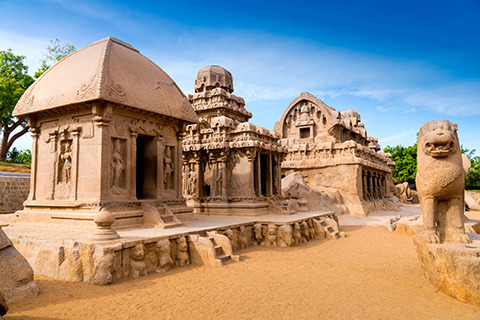 1. Rathas: Carved out of single stones in the shape of chariots, these are temples dedicated to different forms of God Shiva, God Vishnu, and Goddess Durga. The five Rathas temple (A group of five temples) symbolizes the five different characters.
1. Rathas: Carved out of single stones in the shape of chariots, these are temples dedicated to different forms of God Shiva, God Vishnu, and Goddess Durga. The five Rathas temple (A group of five temples) symbolizes the five different characters.
It is also called as Pandavas temple. While they share certain common elements, each of them is distinct in size, shape, and artwork. A few meters away from the Five Rathas group, another similar kind of artwork can be seen in Ganesh Ratha.
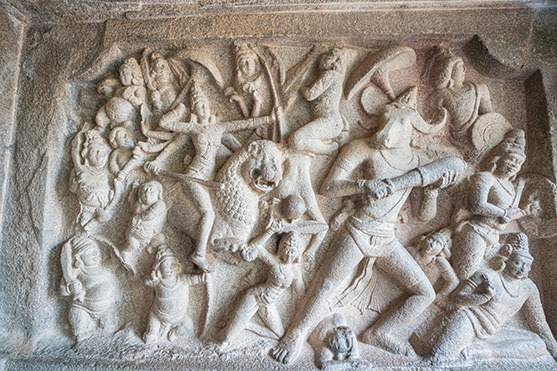 2. Mandapas: Also called the cave temples, one will find many monuments of this pattern. Huge stones are hollowed deep to create a hall-like space with many pillars. The interiors of these rock-cut caves are inscribed with various idols or legends.
2. Mandapas: Also called the cave temples, one will find many monuments of this pattern. Huge stones are hollowed deep to create a hall-like space with many pillars. The interiors of these rock-cut caves are inscribed with various idols or legends.
While many of them could have been used for temples, some might have been used as ritual gatherings or ceremonies. Some of the beautifully carved cave temples are Varaha, Dharamraja, Ramanuja, Krishna, and Mahishasurarmardini.
 3. Structural Temples: Unlike the above two, where temples were either carved out of the rock or carved into the rock, here the rock-cut stones were used to build these temples. Very few of these structures have survived.
3. Structural Temples: Unlike the above two, where temples were either carved out of the rock or carved into the rock, here the rock-cut stones were used to build these temples. Very few of these structures have survived.
One is Mukund Narayan temple, which is very close to Five Rathas, and the second one is just above the Mahishasuramardini rock-cut cave and is called Olakkanesvara Temple. The British used it as a lighthouse and, therefore, it is also famous as the Old Lighthouse. The third and the most popular is a shore temple complex, which is believed to be the only surviving structure among the seven others that once glorified this complex.
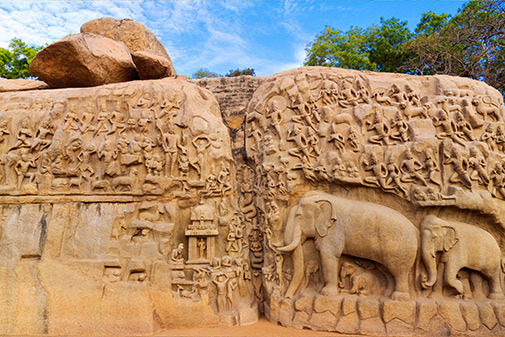 4. Rock Reliefs: These reliefs didn't serve as a temple or gathering space for rituals but a canvas for the artisan to inscribe the legends, myths, or just his imagination.
4. Rock Reliefs: These reliefs didn't serve as a temple or gathering space for rituals but a canvas for the artisan to inscribe the legends, myths, or just his imagination.
Arjuna's penance is among the world's largest bas reliefs works, carved on 27 meters long and 09 meters high boulder. The carvings on it have two major themes from Indian mythology; Arjuna's efforts in the epic 'Mahabharata' and Bhagiratha's efforts to bring river Ganges on earth.
Enjoy Mahabalipuram with a short video.
CHETTINAD
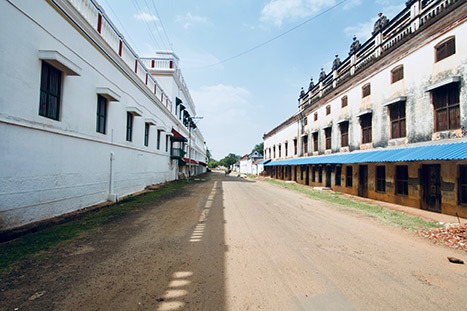 Chettinad, a quaint town in Tamil Nadu, holding a rich heritage of the Nattukotai Chettiar Community, is nothing less than an open-air museum for art and history lovers.
Chettinad, a quaint town in Tamil Nadu, holding a rich heritage of the Nattukotai Chettiar Community, is nothing less than an open-air museum for art and history lovers.
Also, termed as Pioneers of banking, Chettiars were believed to migrate from Kanchipuram to Poompuhar before finally settling in Chettinad.
Their business flourished as they sold salt in the hinterland of Tamil Nadu and brought rice from hinterland to sell them in the coastal areas. Few generations later they went to other countries in search of greener pastures, and settled as bankers and money lenders there. The-accumulated wealth was used in constructing massive and opulent mansions in their home towns.
 Thus, a distinct regional architectural tradition developed, characterized by the combination of traditional Tamil and European architectural elements and the incorporation of luxurious imported building materials such as teak from Burma, marble from Italy, Satin wood from Srilanka, cast iron and steel from Great Britain, chandeliers from Belgium, France and Italy etc.
Thus, a distinct regional architectural tradition developed, characterized by the combination of traditional Tamil and European architectural elements and the incorporation of luxurious imported building materials such as teak from Burma, marble from Italy, Satin wood from Srilanka, cast iron and steel from Great Britain, chandeliers from Belgium, France and Italy etc.
A typical Chettinad mansion with a large façade and porches has multiple courtyards, and each courtyard has multiple rooms around it.
First there is a large platform on either side of the central corridor, where the host would entertain male guests and over here there are granaries as well. The first courtyard, leads into rooms meant for married sons. The second courtyard has space for dining. The third courtyard was the women quarters, while the fourth courtyard was reserved for kitchen and servants, with cowsheds in the backyard. On the main entrance of many houses, you may also find a garage on either side of the gate, which was used to park the horse carts.
 It was pretty common for three to four generations to dwell together in a single house before separate houses were built by individual sons. Some of these mansions are known to possess as many as 100 rooms.
It was pretty common for three to four generations to dwell together in a single house before separate houses were built by individual sons. Some of these mansions are known to possess as many as 100 rooms.
You will be amazed to see the planning by simple but intelligent artisans in the 18th century. These mansions, built with tonnes of teak wood were designed to withstand natural calamities like earthquakes and floods. The platforms were raised to keep the house high during the floods. Even though the structures are large, they ensured that each part of the house is well ventilated and lit by the natural sunlight. They also kept in mind the hot weather and water conservation, while designing these mansions. Amazingly, one will never feel the need to use fans inside an authentic Chettinad house let alone air conditioning. It would be hard for anyone to believe the innovation used in these houses to implement water harvesting in those times. Rainwater falling on the house goes through the covered and interconnected street channels, to reach the final tank outside the village at a designated area. This water was later supplied back to the homes. The innovation does not stop here; they plastered the house walls with a paste made of egg white, grated lemon peel, and an extract from the roots of various tropical trees to make it lookalike marble.
Another unique feature of these houses is the elaborately carved front door. The level of detailing in each of the element was such that it used to take three years for a carpenter with two assistants to carve a single door and lintel. Pretty unusual, but these main doors usually had a 01 feet long key as well.
By the 20th century, these businessmen shifted to bigger cities leaving the homes in the hands of caretakers and limiting their use for festivals and celebrations or could no longer pay for their upkeep. At their peak, there were 110000 Chettiars in 96 villages with 60000 mansions. Today there are 73 villages with only 25000 mansions left.
The best way to explore is to take a ride on an ox cart (One can also use a car or explore by foot) around a village and be driven through, admiring the beauty of these mansions on both sides of the street. There are still many well-preserved houses to show around, while some have been converted into hotels. One can imagine the town's grandeur in its heydays, which, even today, is maintaining its charm.
 Chettiyar's, who were originally vegetarian, had a trade influence in their cuisine as well. One would surely want to taste the Chettinad cuisine with black rice and traditional spices or the most favoured dish of Chettinadu Chicken curry.
Chettiyar's, who were originally vegetarian, had a trade influence in their cuisine as well. One would surely want to taste the Chettinad cuisine with black rice and traditional spices or the most favoured dish of Chettinadu Chicken curry.
A cooking demonstration of the Chettinad cuisine with an expert or a scrumptious meal on a banana leaf is the most desired, after a visit through these exquisite Mansions.
Our tip for an add-on: Visit the nearby Athangudi village to see the making of Athangudi Tiles, which is unique to that village.
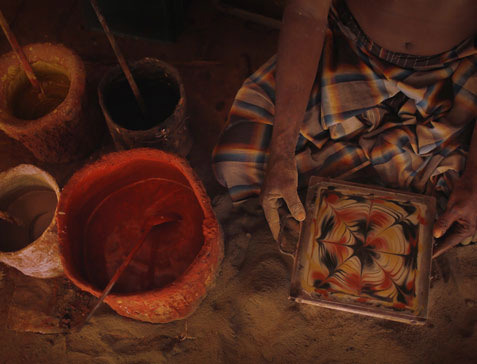 The construction boom in this region during the 18th century made way to these handmade traditional patterned tiles, which were used in the Mansions of Chettinad along with imported tiles. The local families here passed on this art of making eco-friendly handmade tiles from generation to generation.
The construction boom in this region during the 18th century made way to these handmade traditional patterned tiles, which were used in the Mansions of Chettinad along with imported tiles. The local families here passed on this art of making eco-friendly handmade tiles from generation to generation.
Enjoy Chettinad with a short video.
It is no justice to sum up these mesmerising Open air museums or Art Galleries of India in just a few words, as there are much more impressions to be had on a visit to these places. At Indo Asia Tours, the itinerary is not just a travel route or a trip. We design, conceptualise and handcraft every journey for you. Our bespoke itineraries and curated experiences in different destinations are what make for those memorable travel moments.
|
Virtual Destination Training Program
|
 We can conduct a virtual destination awareness training program for your team or yourself or a virtual tour for your clients. Let us know the destination of your interest along with your convenient date / time and we will be happy to set up a program for you.
We can conduct a virtual destination awareness training program for your team or yourself or a virtual tour for your clients. Let us know the destination of your interest along with your convenient date / time and we will be happy to set up a program for you.
Send Request
|
Please feel free to write back to us at marketing@indoasiatours.com to share our thoughts on customized journeys covering the Indian subcontinent or take time to visit our website https://www.indoasia-tours.com. Be sure we will prepare the best program to make a memorable trip for your esteemed clients!
|
|


 Hampi, a UNESCO world heritage site, which also happens to be a pilgrimage site for the Hindus, has a glorious past. Settled near Tungabhadra River, the Vijayanagara Empire's Capital City, Hampi, was a grand city known for its prosperity and wealth in the 14th century. It was the wealthiest city in India and the second largest medieval era city in the world and, in good times, had attracted traders from as far as Persia and Portugal.
Hampi, a UNESCO world heritage site, which also happens to be a pilgrimage site for the Hindus, has a glorious past. Settled near Tungabhadra River, the Vijayanagara Empire's Capital City, Hampi, was a grand city known for its prosperity and wealth in the 14th century. It was the wealthiest city in India and the second largest medieval era city in the world and, in good times, had attracted traders from as far as Persia and Portugal.  It is the region well known for frescos covered abandoned Havelis (Mansions) beholding the stories of its heydays. Right from the 14th century, Shekhawati had a very strategic location on the trade route between ports of Gujarat and cities around the Ganges plains. The towns in Shekhawati served as the trading posts, and the traders started constructing their Havelis (mansions) here. As the businesses flourished with time, the region saw a large number of Havelis being constructed between the 18th and 20th centuries.
It is the region well known for frescos covered abandoned Havelis (Mansions) beholding the stories of its heydays. Right from the 14th century, Shekhawati had a very strategic location on the trade route between ports of Gujarat and cities around the Ganges plains. The towns in Shekhawati served as the trading posts, and the traders started constructing their Havelis (mansions) here. As the businesses flourished with time, the region saw a large number of Havelis being constructed between the 18th and 20th centuries.
 When one enters the town, Havelis, with paintings on different themes, mostly from Hindu epics like 'Ramayana' and 'Mahabharata' lying on both sides of the streets, welcome the passersby.
When one enters the town, Havelis, with paintings on different themes, mostly from Hindu epics like 'Ramayana' and 'Mahabharata' lying on both sides of the streets, welcome the passersby.
 Many villages in the Shekhawati region possess these abandoned Havelis, forts, and temples, but Mandawa and Nawalgarh have some well-preserved Havelis, with some converted into hotels as well.
Many villages in the Shekhawati region possess these abandoned Havelis, forts, and temples, but Mandawa and Nawalgarh have some well-preserved Havelis, with some converted into hotels as well.
 Also known as Mamallapuram, it got its name from the legend, wherein demon king Mahabali was killed by Lord Vishnu (Hindu God). Ruled by Pallavas between the 03rd and 09th century CE, it was among the two major port cities of their kingdom.
Also known as Mamallapuram, it got its name from the legend, wherein demon king Mahabali was killed by Lord Vishnu (Hindu God). Ruled by Pallavas between the 03rd and 09th century CE, it was among the two major port cities of their kingdom.
 1. Rathas: Carved out of single stones in the shape of chariots, these are temples dedicated to different forms of God Shiva, God Vishnu, and Goddess Durga. The five Rathas temple (A group of five temples) symbolizes the five different characters.
1. Rathas: Carved out of single stones in the shape of chariots, these are temples dedicated to different forms of God Shiva, God Vishnu, and Goddess Durga. The five Rathas temple (A group of five temples) symbolizes the five different characters.
 2. Mandapas: Also called the cave temples, one will find many monuments of this pattern. Huge stones are hollowed deep to create a hall-like space with many pillars. The interiors of these rock-cut caves are inscribed with various idols or legends.
2. Mandapas: Also called the cave temples, one will find many monuments of this pattern. Huge stones are hollowed deep to create a hall-like space with many pillars. The interiors of these rock-cut caves are inscribed with various idols or legends.
 3. Structural Temples: Unlike the above two, where temples were either carved out of the rock or carved into the rock, here the rock-cut stones were used to build these temples. Very few of these structures have survived.
3. Structural Temples: Unlike the above two, where temples were either carved out of the rock or carved into the rock, here the rock-cut stones were used to build these temples. Very few of these structures have survived.
 4. Rock Reliefs: These reliefs didn't serve as a temple or gathering space for rituals but a canvas for the artisan to inscribe the legends, myths, or just his imagination.
4. Rock Reliefs: These reliefs didn't serve as a temple or gathering space for rituals but a canvas for the artisan to inscribe the legends, myths, or just his imagination.
 Chettinad, a quaint town in Tamil Nadu, holding a rich heritage of the Nattukotai Chettiar Community, is nothing less than an open-air museum for art and history lovers.
Chettinad, a quaint town in Tamil Nadu, holding a rich heritage of the Nattukotai Chettiar Community, is nothing less than an open-air museum for art and history lovers.
 Thus, a distinct regional architectural tradition developed, characterized by the combination of traditional Tamil and European architectural elements and the incorporation of luxurious imported building materials such as teak from Burma, marble from Italy, Satin wood from Srilanka, cast iron and steel from Great Britain, chandeliers from Belgium, France and Italy etc.
Thus, a distinct regional architectural tradition developed, characterized by the combination of traditional Tamil and European architectural elements and the incorporation of luxurious imported building materials such as teak from Burma, marble from Italy, Satin wood from Srilanka, cast iron and steel from Great Britain, chandeliers from Belgium, France and Italy etc.
 It was pretty common for three to four generations to dwell together in a single house before separate houses were built by individual sons. Some of these mansions are known to possess as many as 100 rooms.
It was pretty common for three to four generations to dwell together in a single house before separate houses were built by individual sons. Some of these mansions are known to possess as many as 100 rooms.
 Chettiyar's, who were originally vegetarian, had a trade influence in their cuisine as well. One would surely want to taste the Chettinad cuisine with black rice and traditional spices or the most favoured dish of Chettinadu Chicken curry.
Chettiyar's, who were originally vegetarian, had a trade influence in their cuisine as well. One would surely want to taste the Chettinad cuisine with black rice and traditional spices or the most favoured dish of Chettinadu Chicken curry.
 The construction boom in this region during the 18th century made way to these handmade traditional patterned tiles, which were used in the Mansions of Chettinad along with imported tiles. The local families here passed on this art of making eco-friendly handmade tiles from generation to generation.
The construction boom in this region during the 18th century made way to these handmade traditional patterned tiles, which were used in the Mansions of Chettinad along with imported tiles. The local families here passed on this art of making eco-friendly handmade tiles from generation to generation.
 We can conduct a virtual destination awareness training program for your team or yourself or a virtual tour for your clients. Let us know the destination of your interest along with your convenient date / time and we will be happy to set up a program for you.
We can conduct a virtual destination awareness training program for your team or yourself or a virtual tour for your clients. Let us know the destination of your interest along with your convenient date / time and we will be happy to set up a program for you.




